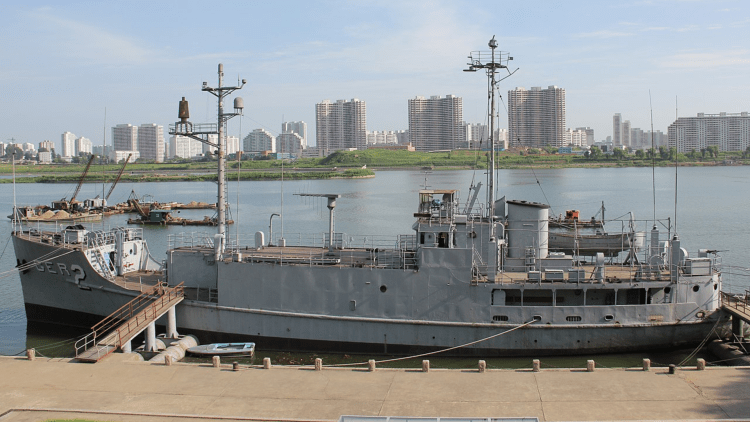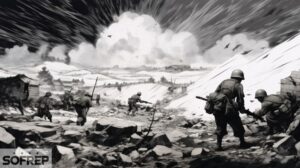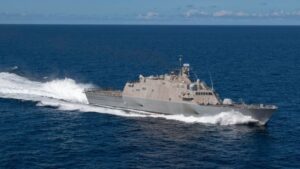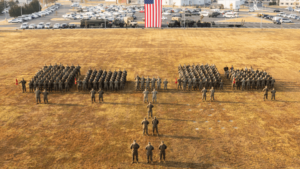US Army Cargo Vessel FP-344 in 1944 before she became USS Pueblo (Image source: Wikimedia Commons)
Here, the Pueblo underwent a covert transformation, with its outward appearance remaining that of an innocuous research vessel, but beneath the unassuming hull, a secret world unfolded.
The Navy reclassified the Pueblo as an Auxiliary General Environmental Research (AGER) ship, a seemingly mundane designation that masked its true purpose—a highly specialized electronic intelligence-gathering “spy” vessel.
Equipped with an array of sophisticated antennas and specialized listening devices, the Pueblo was tasked with collecting crucial intel on North Korea’s military capabilities and communication patterns.
Operating under the cloak of oceanographic research, the ship patrolled international waters bordering North Korea, gathering vital electronic data that would be analyzed by US intelligence agencies.
These undercover missions were a critical component of the US Navy’s Cold War intelligence-gathering efforts, and its operation was sailing along smoothly until that fateful January day in 1968.
A Fateful Encounter: Cat and Mouse on the Open Sea
The USS Pueblo (AGER-2), under the command of Lieutenant Commander Lloyd Bucher, found itself in a precarious situation alongside the 82 crew members onboard.
Operating approximately 13 nautical miles (24 kilometers) off the coast of North Korea, well within international waters according to the US, the ship was approached by a pair of North Korean submarine chasers.
The initial interaction seemed innocuous. The North Koreans requested identification and the Pueblo’s purpose in the area. However, tensions escalated quickly as more North Korean vessels surrounded the American ship.
Despite Commander Bucher’s attempts to de-escalate the situation and assurances of their legitimate research mission, the Pueblo remained trapped.
A map showing the Pueblo’s position (according to North Korea’s narrative) when it was captured is displayed inside the ship, which serves as a museum in Pyongyang. (Image source: Wikimedia Commons)
Shots Fired and Lines Crossed
The events that unfolded next remain a subject of debate.
The US maintains that the Pueblo never crossed into North Korean territorial waters and did not initiate any hostile actions.
North Korea, however, claims the Pueblo violated their territorial sovereignty and ignored warnings to leave the area.
Amidst conflicting narratives, what is certain is that shots were fired.
Accounts differ on the origin of the first shots, but the exchange escalated rapidly.
Outgunned and outnumbered, the Pueblo was ultimately forced to surrender.
Chaos and Confusion: Boarding and Capture
The boarding of the Pueblo was a chaotic and violent affair.
North Korean forces swarmed the ship, overpowering the crew and seizing control.
Communication equipment was destroyed, and the American sailors were subjected to rough treatment and torture.
Confusion reigned as the crew struggled to understand what was happening and their captors’ true intentions.
A Nation on Edge: The Pueblo Incident Takes Center Stage
News of the Pueblo’s capture sent shockwaves through the international community.
The US government vehemently denied any wrongdoing, insisting that Pueblo was on a legitimate research mission in international waters.
North Korea, on the other hand, accused the US of blatant espionage and held the crew captive for months.
The Pueblo incident became a major international crisis, raising fears of a potential escalation of the Cold War.
Diplomatic channels buzzed with activity as the US pressured North Korea for the crew’s release while the world watched with bated breath.
Enduring Captivity and Eventual Freedom
For the 83 crew members of the Pueblo, the capture marked the beginning of a harrowing ordeal.
Confined to cramped quarters and subjected to harsh interrogations, they endured physical and mental hardship.
Access to communication with loved ones was also limited, with the uncertainty of their fate looming large.
However, amidst the fear and isolation, the crew displayed remarkable resilience.
They drew strength from each other, sharing stories and forging an unbreakable bond that helped them survive this unimaginable situation.
Until, finally, after eleven long months of captivity and painstaking negotiations between the two countries, the crew of the Pueblo was released two days before Christmas day, 1968.
The crew of the USS Pueblo upon their release on December 23, 1968. (Image source: Wikimedia Commons)
Their ordeal was over, but the scars remained. The physical and psychological trauma of their captivity would stay with them for years to come. Not to mention that of the 83 crew, only 82 returned home to the stateside alive.
During the initial confrontation, Fireman FN Duane Hodges, a 21-year-old crew member from Creswell, Oregon, was mortally wounded while attempting to destroy classified documents as tensions escalated.
As the men crossed the Bridge of No Return back into South Korea, they carried with them the body of Hodges.
A Reminder of a Bygone Era
Today, the USS Pueblo (AGER-2) remains in North Korean hands, a rusting symbol of a bygone era.
It’s currently docked on the Pothonggang Canal in Pyongyang, and it has been displayed there as a museum ship at the Victorious War Museum since early 2013.
Though captured by North Korea in 1968, the US still considers it a commissioned vessel of the Navy.



